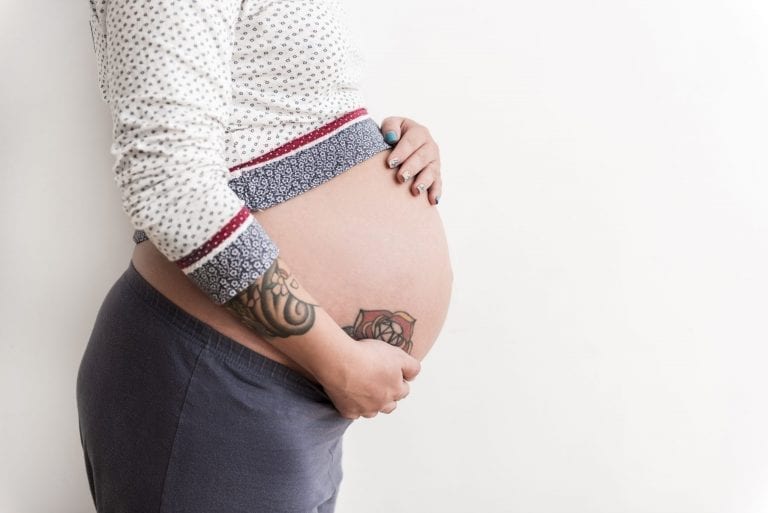Tattoos and Pregnancy: Here’s what you need to know before you go get new ink or a piercing
Getting a tattoo or piercing is typically a choice with special meaning. However, experts advise that adding body art or piercings can create complications during pregnancy, birth, and breastfeeding. Discuss what your tattoos or body jewelry means to you with your pregnancy care provider, so that it can be considered in the full context of your pregnancy care, especially birth and breastfeeding.
If you don’t yet have a tattoo or a piercing, experts agree that pregnancy isn’t a time to add permanent body art, which can lead to skin and hypersensitivity reactions that may require treatment. Their advice aligns with the professional standards set by the Alliance for Professional tattooists, which advices against new tattoos during pregnancy.
When performed by well-trained and experienced technicians under hygienic conditions, piercing and tattooing carry relatively few serious health risks.
Amateur piercing and tattooing put you at far greater risk for infectious disease and traumatic injury, such as infection, bleeding, allergic reaction to inks or metals, and body trauma or scarring. Tongue piercings also increase oral health risks, such as infection or bleeding.
During pregnancy, your abdomen and breasts expand as your skin stretches to accommodate baby and all of the extra blood and fluids that are a normal part of a healthy pregnancy. These changes can actually change the appearance of existing tattoos, which may not return to normal post-pregnancy.
Extra caution is advised regarding new tattoos on your lower back because the use of a large, hollow-bore needle can move tattoo ink or contaminants into your epidural space, and there is a less common risk of developing arachnoiditis. This painful disorder happens when the arachnoid, which is one of the membranes surrounding and protecting your spinal cord, gets inflamed. Symptoms include a burning sensation and painful stinging. Although considered uncommon, this inflammatory issue can lead to future neurological problems.
Tattoos and breastfeeding
Little is known about whether getting new tattoos while nursing is safe. The biggest risk is exposing your breast milk and baby to contaminants from liquid tattoo ink, which could lead to infection or hypersensitivity. Breastfeeding experts at La Leche League International recommend that new tattoos be delayed until your baby is at least 8 months old and is no longer fully dependent on breast milk for their main nutrition. For the same reasons, they also suggest laser tattoo removal be avoided entirely as it can cause fragmented pigment particles to free circulate within your body.
Piercing during pregnancy and breastfeeding
Infection and complications with birthing are the main concerns with existing and new piercings during pregnancy, especially if those infections require medications that could also affect your developing baby.
Jewelry can also complicate childbirth. It may seem common sense, but body jewelry should be removed for birth and especially for breastfeeding because of choking risks for baby during nursing.
Most healthcare providers agree that it’s best to avoid adding body jewelry through new piercings during pregnancy because piercing tracts can get infected by either bacteria or viruses—this is especially true for the outer rim of your ears, which if they become infected during pregnancy, may require IV antibiotics to heal.
And just as your expanding abdomen and skin can change tattoos, the same is true for implanted jewelry and naval piercings. Some moms have required surgical removal for body jewelry at the end of pregnancy when this happens.
SEE ALSO: Understanding Women’s Health Screening
Body piercing and childbirth
Ideally, all body jewelry should be removed before labor. The rigors of labor increase the risk of snagging or tearing. During cesarean procedures, metal implanted jewelry can become hot and present a burn risk. Mouth jewelry increases your risks of breathing problems and possible choking. It can also block your airway if you need general anesthesia.
Abdominal jewelry within or just under your skin may limit surgical access, and postpartum swelling of the vulva can cause jewelry to become embedded in your tissues.
Body piercing and nursing
There’s not a lot of research on the effects of nipple piercing on breastfeeding, and most healthcare providers advise removing body jewelry prior to nursing. Some observations have been made about slowing milk let-down because of nerve damage, increased nipple sensitivity, and blocked milk flow due to scarring of the milk ducts.
Leaking milk or colostrum can happen when piercing tracts lead to a poor latch or baby gagging at the breast. Nipple jewelry poses a serious breathing risk for baby with observations of barbell jewelry breaking apart during nursing. The presence of jewelry can also affect baby’s developing mouth and palate.
As many as 1 in 5 women experience allergic reactions to the metals in tattoo ink or body jewelry
Maintain your piercings
Healthcare providers know how to remove body jewelry in urgent situations. Piercing tracts can close quickly so swapping your metal for plastic jewelry can help maintain the piercing during pregnancy and birth.
This article was adapted from a journal article published in Nursing for Women’s Health.






Comments are closed.